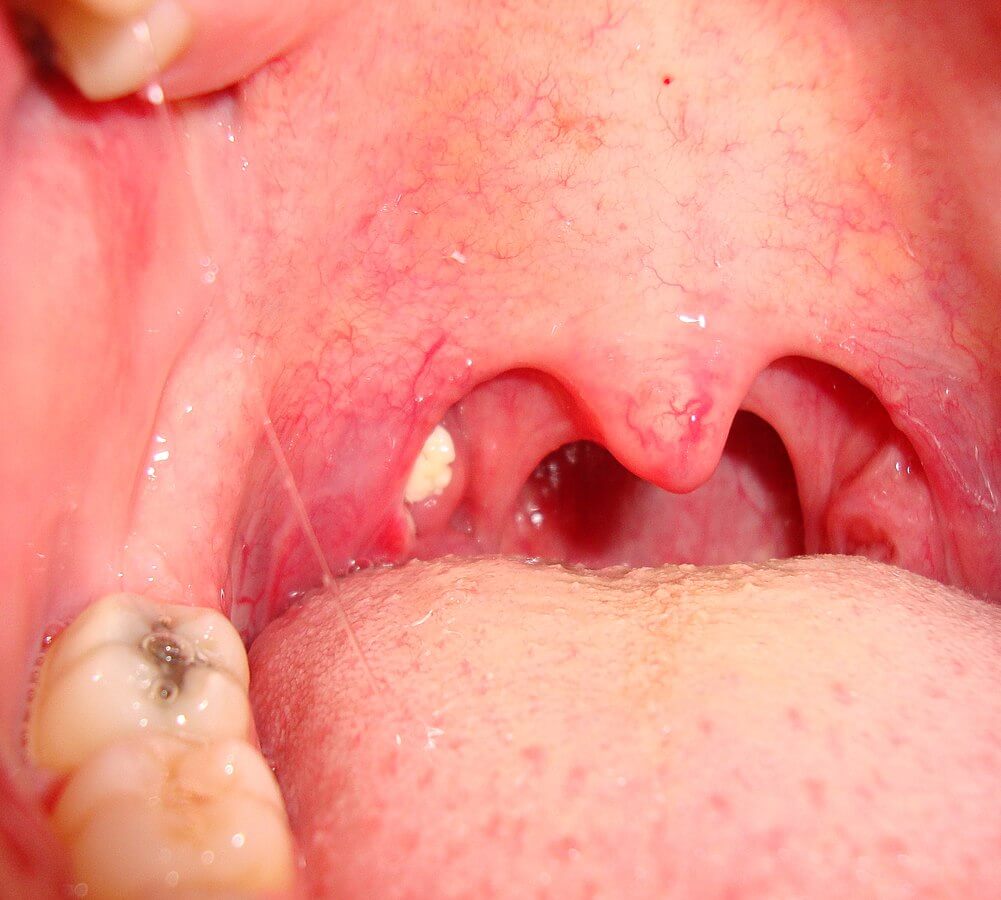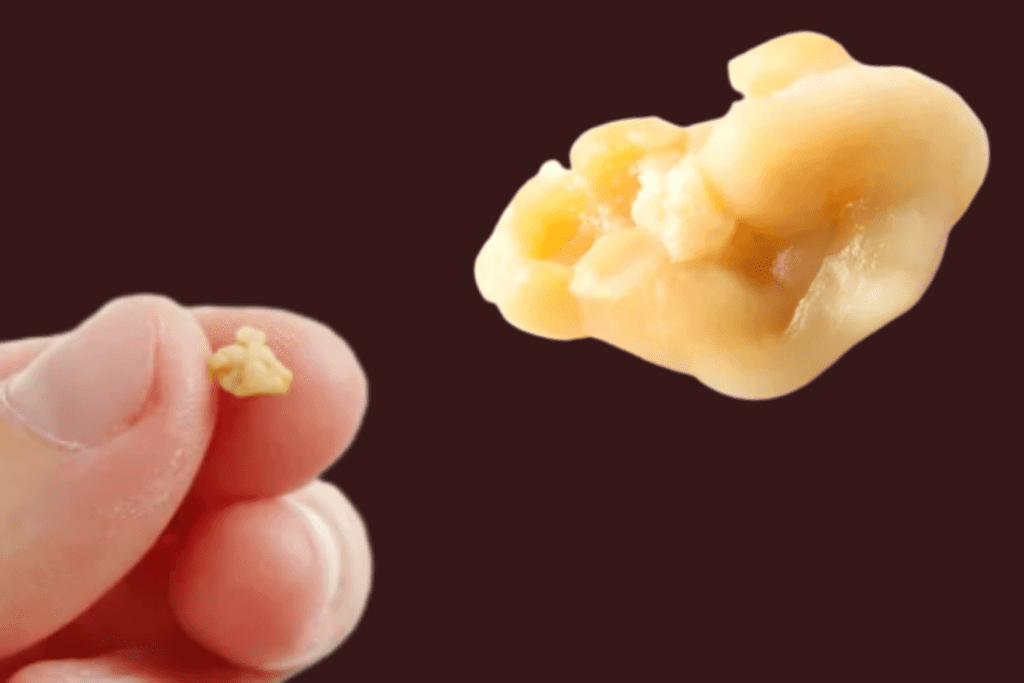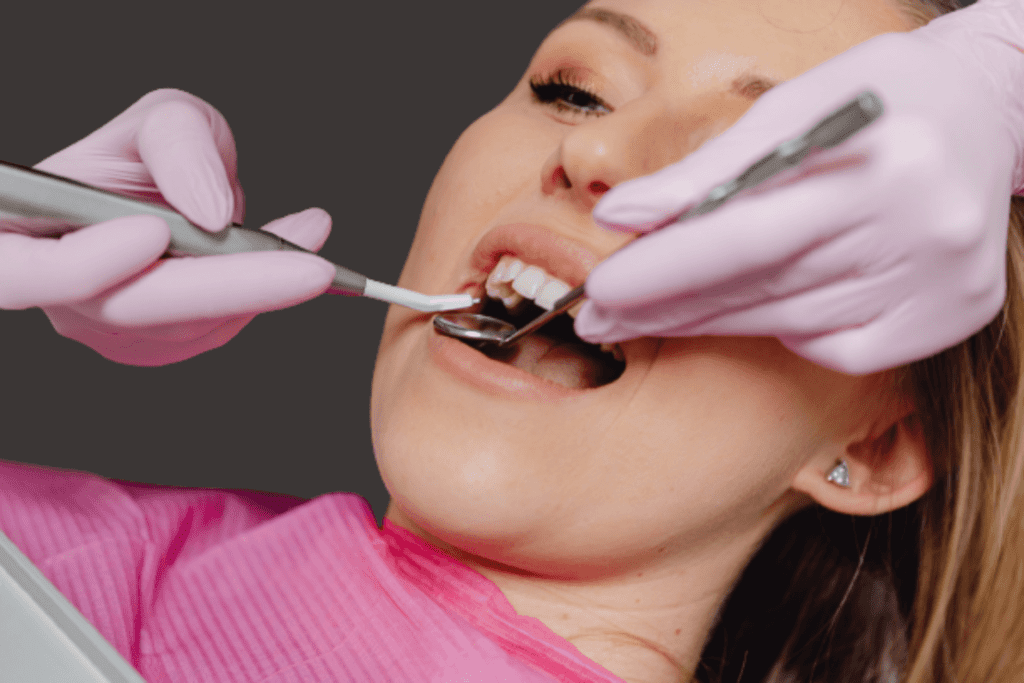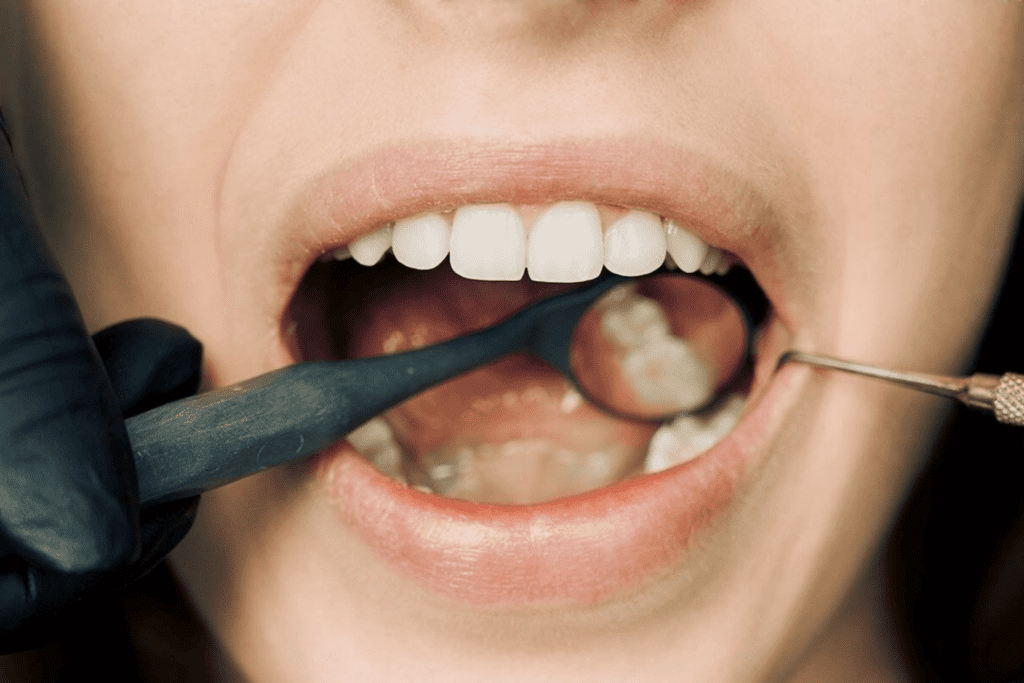Tonsil stones, also known as tonsilloliths, are small, hard calcified deposits that form on the crevices of the tonsils. They are composed of bacteria, dead cells, food particles, and mucus that become trapped in the tonsil crypts. tonsilloliths are often white or yellowish and can range in size from a grain of rice to a pea.
Table of Contents
ToggleWhat are Tonsil Stones Symptoms?
Tonsil stones can present various symptoms, which can vary in severity from person to person. Common symptoms of tonsilloliths include:

Bplikerd, CC BY 3.0, via Wikimedia Commons
Bad Breath (Halitosis)
Tonsil stones emit a foul odor due to the accumulation of bacteria, debris, and decaying matter. The smell can be quite strong and persistent, even with regular brushing and mouthwash.
Sore Throat
Tonsilloliths can cause irritation and inflammation in the tonsils, leading to a sore throat. The discomfort may range from mild to severe, depending on the size and location of the tonsilloliths.
White Debris or Spots
Tonsil stones often appear as small white or yellowish lumps or spots on the surface of the tonsils. These formations are the result of the accumulation of bacteria, dead cells, food particles, and mucus.
Difficulty Swallowing
When tonsilloliths grow larger or multiple small ones are present, they can create a sensation of a foreign object or lump in the throat, making swallowing uncomfortable or even painful.
Ear Pain
Tonsil stones can sometimes cause referred pain in the ears. This happens because the same nerve pathways that serve the tonsils also connect to the ears, leading to earaches or a feeling of discomfort in the ears.
Persistent Cough
Tonsilloliths, especially when located near the opening of the throat, can trigger a chronic cough or an urge to clear the throat. The presence of the stones can irritate the throat and stimulate the cough reflex.
Tonsillitis or Recurrent Infections
Tonsil stones can contribute to the development of tonsillitis, which is an inflammation of the tonsils. The presence of tonsilloliths can create an environment conducive to the growth of bacteria, increasing the risk of recurrent tonsillitis or other throat infections.
What Causes Tonsilloliths?
Tonsil stones, or tonsilloliths, develop when debris such as bacteria, dead cells, food particles, and mucus accumulate and become trapped in the crevices and crypts of the tonsils. Several factors contribute to the formation of tonsilloliths:
Poor Oral Hygiene
Inadequate oral hygiene practices, such as irregular brushing, flossing, and gargling, can lead to the buildup of bacteria and debris in the mouth and tonsils. The bacteria can thrive and multiply, forming a biofilm on the surface of the tonsils. Over time, this biofilm can trap food particles, dead cells, and mucus, leading to the formation of tonsilloliths.
Tonsil Structure
The structure of the tonsils can vary among individuals. Some people have larger tonsil crypts or crevices, which are natural indentations and pockets on the surface of the tonsils. These crypts can accumulate more debris compared to individuals with smaller or shallower crypts. The accumulated debris becomes a breeding ground for bacteria and contributes to the formation of tonsil stones.
Chronic Tonsillitis or Recurrent Throat Infections
Tonsil stones are more common in individuals who experience chronic inflammation or recurrent infections of the tonsils. Inflammation in the tonsils can cause enlargement of the crypts and alter the normal functioning of the tonsils, leading to an increased risk of debris accumulation. The presence of bacteria and the body’s immune response to the infection can also contribute to the development of tonsilloliths.
Post-Nasal Drip
Post-nasal drip occurs when excess mucus produced by the nasal passages drips down the back of the throat. This can introduce additional debris, such as mucus, into the tonsil crypts. The excess mucus, combined with other factors like bacteria and food particles, can contribute to the formation of tonsil stones.
Diet and Lifestyle
Certain dietary choices and lifestyle factors can contribute to the development of tonsil stones. Consuming a diet high in sugar and dairy can promote the growth of bacteria in the mouth and tonsils, increasing the likelihood of tonsil stone formation. Smoking and excessive alcohol consumption can also contribute to the growth of bacteria and the accumulation of debris in the tonsils.
How to Remove Tonsil Stones at Home?

1. Gargling with salt water
Salt water gargles can help dislodge tonsil stones and reduce inflammation. Mix half a teaspoon of salt in a glass of warm water until it dissolves completely. Take a sip of the solution and tilt your head back slightly. Gargle the salt water for 10-15 seconds, making sure it reaches the back of your throat. Spit out the mixture and repeat as necessary. The saltwater helps break down the tonsilloliths and may provide temporary relief from discomfort.
2. Oral Irrigation
Oral irrigation devices, such as water flossers or syringes without needles, can be used to flush out tonsil stones. Fill the device with lukewarm water and position it near the tonsil stone. Gently direct the water stream into the tonsil crypts, applying enough pressure to dislodge the stones. Be cautious not to use excessive force to avoid causing injury. Repeat the process as needed, and thoroughly clean the oral irrigation device after each use.
3. Cotton Swab or Q-tip
If the tonsil stones are visible and accessible, you can try using a clean cotton swab or Q-tip to gently push on the stone and dislodge it. Be very careful and avoid pushing too forcefully to prevent injury to the tonsils. Make sure to clean the swab thoroughly before and after use to maintain proper hygiene
4. Coughing or Clearing the Throat
Forceful coughing or clearing the throat may help dislodge smaller tonsil stones. By generating a strong airflow and pressure in the throat, you may be able to expel the stones. However, this method is not always effective, and it is important to be gentle to avoid any harm or irritation to the throat.
5. Maintaining Good Oral Hygiene
Practicing good oral hygiene is essential for preventing tonsilloliths. Regular brushing with a soft-bristled toothbrush, flossing to remove debris between teeth, and using an antibacterial mouthwash can help reduce bacteria and food particles that contribute to tonsil stone formation. Additionally, gently brushing or scraping the surface of the tongue can remove bacteria that can migrate to the tonsils.
Tonsil Stones Treatments Options
There are several treatment options available for tonsilloliths, depending on the severity and frequency of the symptoms. Here are some common treatment options:
Watchful Waiting
If the tonsil stones are small and not causing significant symptoms, a watchful waiting approach may be recommended. This means closely monitoring the condition and managing symptoms through good oral hygiene practices. The associated risks of watchful waiting are minimal since no specific treatment is being performed. However, there is a possibility that the tonsilloliths may persist or increase in size, leading to ongoing symptoms.
Manual Removal
Manual removal of tonsilloliths is typically performed by a healthcare professional, such as an ENT specialist. They use specialized tools to extract the stones from the tonsil crypts. To minimize discomfort, the procedure is typically performed under local anesthesia. Risks associated with manual removal include minor bleeding, discomfort during the procedure, and a small possibility of infection. It’s important to have this procedure performed by a trained professional to minimize the risks and ensure effective removal.
Irrigation and Flushing
In this treatment approach, an ENT specialist may use a syringe or water flosser to flush out the tonsil crypts and dislodge the stones. The procedure aims to remove smaller tonsilloliths and reduce the recurrence of symptoms. Risks associated with irrigation and flushing are generally minimal, although there is a slight chance of injury to the tonsils if the procedure is not performed carefully. It’s important to have this procedure performed by a professional who can ensure proper technique and minimize the risks.
Laser Cryptolysis
Laser cryptolysis is a minimally invasive procedure that uses laser energy to reshape or reduce the size of the tonsil crypts. This makes them less likely to trap debris and form tonsil stones. In most cases, the procedure is carried out using local anesthesia. Risks associated with laser cryptolysis include minor postoperative pain, the potential for infection, and a small chance of damage to surrounding tissues. It’s important to have this procedure performed by an experienced ENT specialist who is skilled in laser techniques.
Tonsillectomy
Tonsillectomy involves the surgical removal of the tonsils. It is typically considered a last resort for severe or recurrent tonsil stones that significantly impact a person’s quality of life. Risks associated with tonsillectomy include bleeding, infection, reaction to anesthesia, damage to surrounding structures, prolonged recovery time, and rarely, complications like delayed healing or changes in voice. Tonsillectomy is a major surgical procedure, and its risks should be carefully weighed against the potential benefits.
How to Prevent Tonsilloliths?
Preventing tonsil stones involves maintaining good oral hygiene and adopting certain lifestyle habits. Here are several preventive measures you can implement:
Practice Thorough Oral Hygiene
Maintaining good oral hygiene is crucial in preventing tonsil stones. Ensure you use a toothbrush with soft bristles and fluoride toothpaste to brush your teeth a minimum of two times per day. Pay special attention to the back of your tongue and the area around the tonsils, as bacteria and debris can accumulate there. Additionally, floss daily to remove food particles and plaque between your teeth, and rinse your mouth with an antibacterial mouthwash to help kill bacteria.
Gargle With Salt Water or Non-Alcoholic Mouthwash
Gargling with salt water or non-alcoholic mouthwash can help reduce the bacteria and debris in the mouth and throat, minimizing the chances of tonsil stone formation. Mix half a teaspoon of salt in a glass of warm water, and gargle with the solution for about 10-15 seconds before spitting it out. Alternatively, use an alcohol-free mouthwash that contains antimicrobial agents to help control bacterial growth.
Stay hydrated
Drinking an adequate amount of water throughout the day is essential for maintaining good oral health. Water helps keep your mouth and throat moist, preventing dryness that can contribute to the accumulation of debris and bacteria. Aim to drink at least 8 glasses of water a day to stay properly hydrated.
Limit or Avoid Alcohol and Tobacco
Alcohol and tobacco can promote the growth of bacteria in the mouth and throat, leading to an increased risk of tonsil stone formation. Limit or avoid alcohol consumption, and refrain from smoking or using other tobacco products to minimize the bacterial load in your oral cavity.
Avoid or Reduce Dairy and Sugary Foods
Dairy products and sugary foods can stimulate the production of mucus and provide a favorable environment for bacteria to thrive. Consider reducing your consumption of dairy products and sugary foods to help decrease the production of mucus and minimize the growth of bacteria in the mouth and throat.
Maintain a Healthy Diet
A balanced diet plays a vital role in overall oral health. Incorporate a diverse range of fruits, vegetables, whole grains, and lean proteins into your diet. These nutrient-rich foods can support a healthy immune system, which plays a crucial role in preventing infections and reducing the risk of tonsil stone formation.
Regularly Clean Your Tongue
Bacteria can accumulate on the surface of the tongue and migrate to the tonsils, contributing to tonsil stone formation. Use a tongue scraper or your toothbrush to gently clean the surface of your tongue regularly. This helps remove bacteria and debris, reducing the likelihood of tonsil stone formation.
Avoid Mouth Breathing
Breathing through the mouth can lead to dryness in the mouth and throat, making them more susceptible to bacterial growth and the formation of tonsil stones. If you frequently breathe through your mouth due to nasal congestion or other reasons, it’s advisable to seek medical advice to address any underlying causes and promote proper nasal breathing.
FAQ
Q: What are Tonsil stones?
A: Tonsil stones, also known as tonsilloliths, are small, hard formations that develop in the crevices or crypts of the tonsils. They are made up of debris, such as food particles, dead cells, and bacteria, that become trapped and calcify over time.
Q: Are Tonsilloliths Common?
A: Tonsilloliths are relatively common, but not everyone experiences them. They are more prevalent in individuals who have larger or
more cryptic tonsils.
Q: Can Tonsilloliths be Prevented?
A: While it may not be possible to completely prevent tonsilloliths, certain measures can help reduce their occurrence. Maintaining good oral hygiene, including regular brushing, flossing, and tongue cleaning, can help minimize bacteria and debris in the mouth and throat. Staying hydrated, avoiding tobacco and alcohol, and reducing dairy and sugary foods may also be beneficial.
Q: Do Tonsil Stones Cause Bad Breath?
A: Yes, tonsilloliths can cause persistent bad breath or halitosis. The stones can harbor bacteria and release foul-smelling sulfur compounds, resulting in an unpleasant breath odor.
Q: Can Tonsil Stones be Removed at Home?
A: Small tonsilloliths can sometimes be dislodged or removed at home using methods like gargling with salt water, gently using a cotton swab, or using a water flosser. However, larger or embedded tonsil stones should be evaluated and removed by a healthcare professional.
Q: Are Tonsil Stones Harmful?
A: Tonsilloliths themselves are generally not harmful, but they can cause discomfort and contribute to symptoms like bad breath, sore throat, and difficulty swallowing. In some cases, they can also be associated with recurrent tonsillitis or throat infections.
Q: When Should I See a Doctor About Tonsil Stones?
A: It is advisable to see a doctor if you experience persistent symptoms related to tonsil stones, such as chronic bad breath, throat discomfort, or recurrent tonsillitis. A healthcare professional can provide an accurate diagnosis, recommend appropriate treatment options, or discuss the possibility of tonsillectomy if necessary.
Q: Can Tonsilloliths Come Back After Removal?
A: Yes, tonsil stones can recur even after removal. Adopting preventive measures, maintaining good oral hygiene, and seeking appropriate treatment options can help reduce the likelihood of recurrence. However, individual factors and the anatomy of the tonsils can influence the reoccurrence of tonsilloliths.
Q: What Doctor Removes Tonsil Stones?
A: An ear, nose, and throat (ENT) specialist, also known as an otolaryngologist, is a doctor who typically removes tonsilloliths. ENT specialists specialize in diagnosing and treating conditions related to the ear, nose, and throat, including tonsil stones. They have the expertise and tools necessary to safely and effectively remove tonsil stones. If you are experiencing issues with tonsilloliths, it is advisable to consult with an ENT specialist who can evaluate your condition, provide appropriate treatment options, and perform any necessary removal procedures.
Q: Are Tonsilloliths From Poor Hygiene?
A: Tonsilloliths are not solely caused by poor hygiene, although certain oral hygiene practices can contribute to their formation. Tonsilloliths develop in the tonsil crypts, which are naturally occurring crevices on the surface of the tonsils. They are formed when debris, such as food particles, dead cells, and bacteria, becomes trapped and accumulates in these crypts.
Conclusion
In conclusion, tonsil stones, also known as tonsilloliths, are small, calcified formations that can develop in the crevices of the tonsils. While they may not be harmful, they can cause symptoms such as bad breath, sore throat, and difficulty swallowing. Tonsilloliths can be managed and treated through various methods, including at-home remedies and in-office treatments performed by ENT specialists. Good oral hygiene practices, such as regular brushing, flossing, and tongue cleaning, along with staying hydrated and avoiding certain foods, can help prevent tonsil stone formation. If tonsil stones persist or cause significant discomfort, it is advisable to consult with a healthcare professional for appropriate diagnosis and treatment options tailored to individual needs.
Reference
https://www.ncbi.nlm.nih.gov/pmc/articles/PMC4529540/
https://www.ncbi.nlm.nih.gov/pmc/articles/PMC8218315/
https://pubmed.ncbi.nlm.nih.gov/18037821/
https://share.upmc.com/2015/07/what-are-tonsil-stones-tonsilloliths/
https://bmcoralhealth.biomedcentral.com/articles/10.1186/1472-6831-13-54




